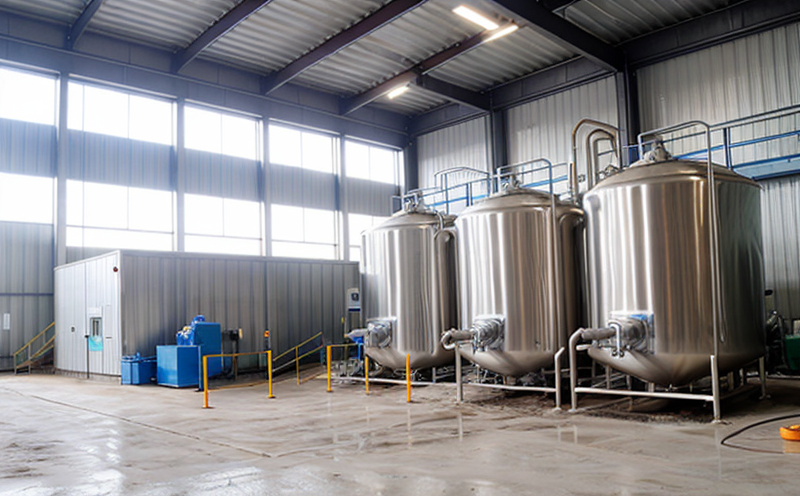ASTM D8221 Legionella Detection Test in Process Water
The ASTM D8221 method is a critical tool used to detect and quantify Legionella pneumophila in industrial process water. This test is essential for ensuring the safety of water systems, particularly those used in industrial processes where exposure risks are high.
Legionella pneumophila is a bacterium that can cause Legionnaires’ disease, a severe form of pneumonia. The presence of this microorganism in industrial process water poses significant health hazards to workers and visitors who may come into contact with the water. By implementing ASTM D8221, facilities can proactively manage these risks and maintain compliance with regulatory standards.
The ASTM D8221 method is designed for use with a variety of process waters, including cooling towers, boiler feedwater, condenser water systems, and other open recirculating systems. The test involves the collection of water samples, followed by the incubation and cultivation of potential Legionella colonies on selective media. Positive identification can be achieved using immunofluorescence microscopy or polymerase chain reaction (PCR) techniques.
The ASTM D8221 method is particularly useful for facilities that have experienced cases of Legionnaires’ disease, as it allows for the early detection and mitigation of potential outbreaks. Regular testing helps maintain a safe working environment and ensures compliance with Occupational Safety and Health Administration (OSHA) standards and World Health Organization (WHO) guidelines.
Proper implementation of ASTM D8221 requires strict adherence to the method's detailed procedures, including sample collection, transportation, and storage. The use of appropriate sampling containers is crucial to prevent contamination and ensure accurate results. Once collected, samples should be transported to a certified laboratory for analysis as soon as possible.
The ASTM D8221 method provides quantitative data on the presence of Legionella in process water, which can help facilities identify potential sources of contamination and implement corrective measures. This information is invaluable for improving water quality and preventing future outbreaks. Facilities that regularly conduct ASTM D8221 testing are better positioned to protect their workforce and comply with regulatory requirements.
Regular monitoring and compliance with ASTM D8221 can also lead to cost savings by preventing the need for more extensive remediation efforts or potential legal liabilities associated with Legionella outbreaks. Additionally, facilities that demonstrate a commitment to safety through regular testing may be able to enhance their reputation as leaders in workplace health and safety.
- How often should ASTM D8221 testing be conducted? Testing frequency depends on the specific facility and its risk factors. However, it is generally recommended that facilities conduct ASTMD8221 testing at least quarterly or following any water system modifications.
- What are the key steps involved in ASTM D8221 sampling? Sampling involves collecting water from various points within the process water system using appropriate containers to prevent contamination. Samples should be transported to the laboratory for analysis as soon as possible.
- Can ASTMD8221 detect all strains of Legionella pneumophila? The ASTM D8221 method is specifically designed to target L. pneumophila, which is responsible for most cases of Legionnaires’ disease.
- Is ASTMD8221 suitable for all types of industrial process water systems? Yes, the method can be adapted for use with a wide range of industrial process water systems, including cooling towers and boiler feedwater.
Why It Matters
The ASTM D8221 Legionella detection test in process water is critical for ensuring the safety of workers and visitors who may come into contact with industrial process water. The presence of Legionella pneumophila can lead to severe health issues, including Legionnaires’ disease, which is a form of pneumonia. By implementing this test, facilities can proactively manage risks and maintain compliance with regulatory standards.
Legionella pneumophila is particularly dangerous because it thrives in warm water systems, such as those used in industrial processes. Once the bacteria are introduced into these systems, they can spread rapidly through the water supply, posing a significant health risk to anyone who comes into contact with the water. This makes ASTM D8221 testing an essential tool for facilities that rely on process water.
Regular ASTMD8221 testing allows facilities to identify potential sources of contamination early and implement corrective measures before an outbreak occurs. This not only helps protect workers and visitors but also prevents the facility from facing costly remediation efforts or legal liabilities associated with Legionella outbreaks. By demonstrating a commitment to safety through regular testing, facilities can enhance their reputation as leaders in workplace health and safety.
Moreover, compliance with ASTM D8221 is not just about meeting regulatory requirements; it also helps ensure that industrial processes are conducted safely and efficiently. Facilities that maintain high water quality standards can expect improved operational performance and reduced downtime due to water-related issues.
Industry Applications
The ASTM D8221 Legionella detection test in process water is widely used across various industries, including manufacturing, energy production, and food processing. In these sectors, the presence of Legionella pneumophila can pose significant risks to workers and visitors who may come into contact with industrial process water.
Manufacturing facilities that use cooling towers or boiler feedwater systems often conduct ASTMD8221 testing to ensure the safety of their water supply. Energy production plants, particularly those that rely on large-scale water systems for operations, also benefit from regular ASTMD8221 testing. Food processing facilities may implement this test to protect workers and visitors who come into contact with process water used in food preparation.
In addition to these industries, ASTMD8221 testing is essential for any facility that has experienced cases of Legionnaires’ disease or other waterborne illnesses. By implementing regular ASTMD8221 testing, facilities can identify potential sources of contamination and implement corrective measures before an outbreak occurs.
Moreover, compliance with ASTM D8221 is not just about meeting regulatory requirements; it also helps ensure that industrial processes are conducted safely and efficiently. Facilities that maintain high water quality standards can expect improved operational performance and reduced downtime due to water-related issues.





